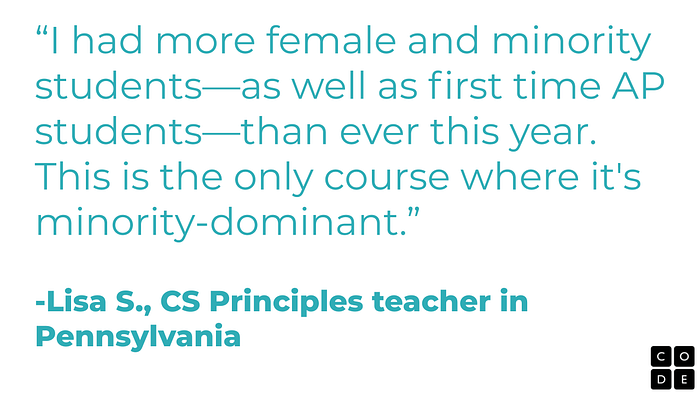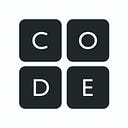Note: As of September 2020, this post contains outdated language or graphics referencing “underrepresented minorities.” To see our current language policy around race, ethnicity, and gender, see this support article.
For the sixth year in a row, the percentage of female AP Computer Science exam takers rose, steadily chipping away at the gender gap in high school computer science.

While the gender gap is closing gradually, total participation is increasing dramatically! Female students and underrepresented minorities set new records this year. Newly-released data on AP Computer Science exams shows the number of female students increased 32%, from 36,709 in 2018 to 48,569 in 2019. Participation by students from historically underrepresented minorities in computing grew 29%, from 28,255 last year to 36,375 in 2019.
The total number of young women and students from historically underrepresented minorities in computing in AP computer science has grown ten-fold since 2013, thanks to the incredible network of educators and organizations that share our mission of broadening access and diversity of participation in K–12 computer science.
What has driven this change?
Landmark study: State policies grow participation by young women
Today—along with our partners The Computer Science Teachers Association (CSTA) and The Expanding Computing Education Pathways (ECEP) Alliance—we’re releasing the 2019 State of CS Education report, analyzing all 50 states (plus D.C.) and their work to expand access and broaden participation in computer science. The report conclusively shows that the policies advanced by these states are directly correlated with improvements in the gender gap and increased participation by young women in computer science.
“This progress is thanks to the incredible teachers that step up every day to bring computer science to their classrooms,” said Jake Baskin, Executive Director of the Computer Science Teachers Association. “We’re on the right track, and continued support for teachers is essential to keep the momentum going.”
These advances are thanks to hundreds of local champions and advocacy partners such as CompTIA, ECEP Alliance, ExcelinEd, and NCWIT, community-building partners such as the CSTA and CSforAll, as well as supportive corporations such as Accenture, Amazon, Facebook, Google, Infosys Foundation USA, and Microsoft. We couldn’t be more thankful for the progress to date, and we still have a long way to go.
“Every young person, no matter where they live, deserves the opportunity to learn 21st century skills,” said Brad Smith, President of Microsoft. “While it is encouraging that the gender gap is narrowing, we need to ensure that more women and people of all backgrounds have greater access to computer science education. It is critical for state leaders to build on this progress to ensure every student is prepared for the digital economy.”
New AP CS Principles course leads in diversity
The improved diversity in AP computer science is particularly boosted by the new AP Computer Science Principles course by the College Board with the support of the National Science Foundation. Since its launch in 2016, CS Principles has changed the face of AP computer science, illustrating how a thoughtfully-designed course can effectively engage a broad, diverse student population.
The data shows that these students want to continue learning CS. According to the College Board, “students who take the AP CSP Exam are nearly 6 times more likely to go on to take CSA compared to other AP STEM examinees, and about 15 times more likely than non-AP STEM examinees.”

Teachers see this impact firsthand. “I had more female and minority students — as well as first time AP students — than ever this year,” said Lisa Slipp, a CS Principles teacher at William Tennent High School in Warminster, Pennsylvania.
Not only did she see high participation, nearly 90% of Slipp’s students passed the exam with a score of 3 or higher. She said the majority of the students in her AP CS Principles classroom were female or underrepresented students of color, and next year she plans to teach a full section of AP CS Principles classes because there is so much demand. “This is the only course where it’s minority-dominant,” she said.
An entire community of organizations and educators working together
Today’s results aren’t the work of any one organization; they’re thanks to an entire community of organizations and educators working together.
At Code.org we’re thankful for our network of 64 regional partners and more than 700 facilitators — they do the hard work of preparing teachers to teach computer science for the first time, from grades K-12.
And beyond Code.org, we join forces with almost a dozen other efforts such as CodeHS, CS50 AP, TEALS by Microsoft, UTeach, and others listed below. Every one of these organizations makes an important contribution to this movement.
“I am truly delighted the see the increased diversity in AP CS,” said Dan Garcia, UC Berkeley Teaching Professor and Co-Principal Investigator of The Beauty and Joy of Computing. “While we should celebrate these numbers, we all know we have a long way to go until every student has equal opportunity and access to this wonderful, engaging, life-changing material.”
We have a very long way to go
Of course, while we are excited to celebrate every step forward, we are quite far from balanced representation in computer science. And besides, the majority of U.S. schools still don’t offer a single course in computer science.
And even in schools that do, although participation by underrepresented groups is breaking records and narrowing gaps every year, we are still far from our goal.
We’re proud that the high school gender gap in computer science has been narrowing steadily, every single year, for six years straight.
We celebrate every step forward by partner organizations and by states that enact policies for change. And we are committed to continuing this work until we reach balanced representation.
This is the power of YOUR movement
Today’s results show the power of a global movement in education. We celebrate the broad network of partners working on this problem — whether it’s nonprofits and universities with programs to broaden participation in CS, philanthropic support from corporations such as Amazon, Facebook, Google, Infosys Foundation USA, Microsoft, or the support of state and federal governments — all our efforts together have caused a historic increase in student participation in computer science, with the greatest gains made by young women and underrepresented minorities. We are thankful for every partner, funder, policymaker, and volunteer who is helping build a better future for our children.
Above all, we applaud and thank the over 1 million classroom teachers who support our vision: that every student in every school should have the opportunity to learn computer science. These teachers are changing the face of computing. They are the heroes of this movement.
Hadi Partovi, Code.org
Here’s what other CS Principles providers and CS community members had to say about this exciting progress:
- “For too long and for too many students has computer science been inaccessible,” said Prof. David J. Malan of Harvard University’s CS50. “But, wonderfully, that’s beginning to change, at an ever-faster rate.”
- “Maintaining a focus on broadening participation in computing in CS advocacy and policy efforts requires access to new data, both locally and nationally,” said ECEP Alliance Director Sarah Dunton. “This national report allows us to disseminate information that immediately sparks conversations, builds connections, and increases action at the state level.”
- “We’re enormously proud to be part of this movement,” said Stefanie Sanford, Chief of Global Policy & External Relations at the College Board. “Changing the invitation to computer science has allowed us to welcome far more talent into the classroom, preparing more students to shape the future.”
- “We’re glad to be involved with the community of teachers, schools, and organizations working to expand access and diversity in AP Computer Science,” said Jeremy Keeshin, CEO and co-founder of CodeHS. “It’s exciting that we can help so many new students learn about computing and hopefully open up the door to many future opportunities.”
- “There’s so much work yet to do in the computer science education ecosystem,” added CodeCombat CEO Nick Winter. “But I’m confident that we’re on the right track to increasing access and engaging all students with this vital subject.”
- “We are so pleased that the AP Computer Science Principles program has been successful in increasing participation and performance among Black, Latinx, and female students,” said June Mark, from the Education Development Center and Project Director of the Beauty and Joy of Computing in New York City. “From the start, the Beauty and Joy of Computing (BJC) team, along with the community of CSP providers, has been committed to diversifying engagement in computer science. We are looking forward to more students enjoying their own creativity and accomplishment through computing in the new school year.”
- Full quote from Dan Garcia, BJC: “As a curriculum provider and also former member of the CS Principles Development Committee, I am truly delighted the see the increased diversity in AP CS thanks to AP CS Principles. From the very beginning of the design of the course (starting for many of us in Chicago on Oct 26, 2008 — more than 10 years ago), the goal has always been broadening participation in computing. The family of educators and providers has put in so many hours toward that effort, and while we should celebrate these numbers, we all know we have a long way to go until every student has equal opportunity and access to this wonderful, engaging, life-changing material. Bravo, members of the CSforALL family, now let’s get back to work!”
